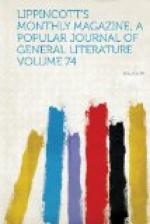The next day the party arrived at the Tombs of the Emperors. These are the tombs of the Ming emperors, one of the most brilliant dynasties of Chinese history. They lie in a circular valley which opens out from a great plain, and is surrounded by limestone peaks and granite domes, forming a barren and waste amphitheatre. The grandeur of its dimensions and the awful barrenness of its desolation make it a fit resting-place for the imperial dead of the last native dynasty. At the foot of the surrounding heights thirteen gigantic tombs, encircled with green trees, are arranged in a semicircle. Five majestic portals, about eight hundred yards apart, form the entrance to the tombs. From the portico giving entrance to the valley to the tomb of the first emperor is more than a league, and the long avenue is marked first by winged columns of white marble, and next by two rows of animals, carved in gigantic proportions. Of these there are, on either side, two lions standing, two lions sitting; one camel standing, one kneeling; one elephant standing, one kneeling; one dragon standing, one sitting; two horses standing; six warriors, courtiers, etc. The lions are fifteen feet high, and the others equally colossal, while each of the figures is carved from a single block of granite.
At the end of the avenue are the tombs, with groups of trees about them. Each tomb is really a temple in which white and pink marble, porphyry and carved teak-wood are combined, not indeed with harmony or taste, but, what is rare in China, with lines of great purity and severity. One of the halls of these tombs is about a hundred feet long by about eighty wide. The ceiling is from forty to sixty feet high, and is supported by rows of pillars, each formed of a single stick of teak timber eleven feet in circumference. These sticks were brought for this purpose from the south of China. Though they have been in position over nine hundred years, they appear as sound as when first posed, nor has the austere splendor of the structure suffered in any degree.
The sombre obscurity well befits these sepulchral dwellings, and the dull sound of the deadened gongs struck by the guardians makes the vaults reverberate in a singular and impressive way. Behind the memorial temple rises an artificial mound about fifty feet high, access to the top of which is given by a rising arched passage built of white marble. On the top of the mound is an imposing marble structure consisting of a double arch, beneath which is the imperial tablet, a large slab, upon which is carved a dragon standing on the back of a gigantic tortoise. The remains of the emperor are buried somewhere within this mound, though the exact spot is not known: this precaution, it is said, was taken to preserve the remains from being desecrated in a search for the treasures which were buried with him, while the persons who performed this last office were killed upon the spot, in order further to preserve the secret.




